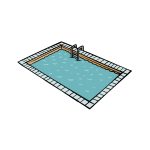Shocking your pool is an essential part of pool maintenance to keep the water clean and safe for swimming. But how often should you shock your pool? Let’s dive into the details to understand the importance of pool shocking and the recommended frequency to ensure crystal clear water.

Credit: clearchoicepoolcaretx.com

Credit: www.homedepot.com
What is Pool Shocking?
Pool shocking, also known as super chlorination, is the process of adding a high dose of chlorine to the pool water to kill bacteria, algae, and other contaminants. This helps maintain proper sanitation and water clarity in your pool.
Importance of Shocking Your Pool
Regularly shocking your pool is crucial to keep the water free from harmful bacteria and algae growth. It helps in breaking down organic matter, such as sweat, body oils, and sunscreen residues, that can accumulate in the water and create a breeding ground for bacteria.
Factors Affecting Pool Shocking Frequency
The frequency of shocking your pool can vary based on several factors, including the pool usage, weather conditions, and water quality. Here are some key factors to consider when determining how often you should shock your pool:
| Factors | Impact |
|---|---|
| Pool Usage | More frequent use may require more frequent shocking. |
| Weather Conditions | Hot weather can lead to faster chlorine loss, requiring more frequent shocking. |
| Water Quality | Poor water quality may necessitate more frequent shocking to restore clarity. |
Recommended Frequency for Pool Shocking
While the ideal frequency for shocking your pool can vary, a general guideline is to shock your pool every 1-2 weeks during the swimming season. However, certain circumstances may require more frequent shocking. Here are some situations when you should consider shocking your pool:
- After heavy rainfall
- Following a pool party or event
- If the water appears cloudy or green
- When there is a strong chlorine smell
Testing Your Pool Water
Regularly testing your pool water is essential to maintain proper water balance and determine when it’s time to shock your pool. Use a test kit to check the chlorine and pH levels of the water. If the chlorine level is consistently low or the water appears cloudy, it’s time to shock the pool.
How to Shock Your Pool
When shocking your pool, follow these steps:
- Read the manufacturer’s instructions on the shock product.
- Calculate the amount of shock needed based on your pool size.
- Dissolve the shock granules in a bucket of water.
- Pour the solution around the perimeter of the pool.
- Run the pool pump for several hours to circulate the water.
- Test the water after 24 hours to ensure the chlorine level has returned to normal.
Conclusion
Shocking your pool is a critical aspect of pool maintenance to ensure clean and safe swimming water. By understanding the factors that influence the frequency of pool shocking and following the recommended guidelines, you can keep your pool water crystal clear and free from contaminants. Remember to test your pool water regularly and shock your pool as needed to enjoy a refreshing and inviting swimming experience.




